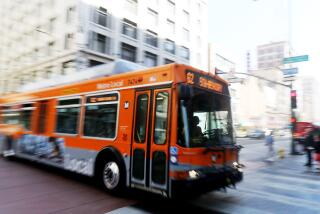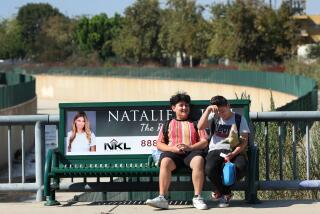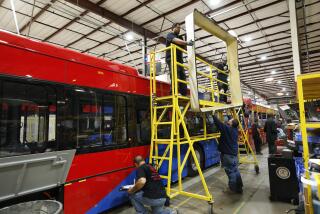OCTD Adopts ‘Stand-Pat’ 5-Year Plan : District Board Wary of Potential Reductions in Federal Aid
- Share via
Although bus ridership is expected to jump from 35 million to 41.3 million passengers a year by 1990, uncertainty about future federal subsidies led Orange County Transit District board members Thursday to adopt a five-year plan that envisions almost no change in service, other than the fine-tuning of current routes and fares.
For example, the outline of the transit district’s goals for the next five years includes the idea of expanding night service on some routes used heavily by people who are dependent on public transit. Routes under study for night service (between 8:30 and 10:30) include some along Beach, Harbor, and Anaheim boulevards, Katella, Edinger and Bolsa avenues, Main and Bristol streets and Laguna Canyon Road.
The plan also names as goals continued engineering and environmental studies of the bus guideways proposed for freeway medians, increasing dial-a-ride service through current contracts with private transit firms and stepping up efforts to promote ride-sharing among commuters and employer-sponsored van pools.
The five-year plan was adopted unanimously, but not before Supervisor Roger Stanton, an OCTD board member, criticized the district’s staff for continuing three routes on which bus ridership is below 15 passengers per hour of service.
Bus ridership has increased 10.5% over last year, thanks to the county’s strong economy and rising employment, district managers told the board members.
Growth Contrary to Trend
Board Chairman Ralph Clark, also a county supervisor, and James Reichert, OCTD general manager, both said the passenger increase is surprising because other public transit operators around the country are carrying fewer passengers.
Transit districts measure financial performance largely on the percentage of operating costs that is covered by fare revenues.
This year, about 23.8%, or $17.4 million of the system’s $73.2 million operating expense is expected to come from the fare box. By 1990, OCTD officials estimate, the farebox return will reach 26.6%.
OCTD revenues from state and federal programs are expected to dip only slightly below the current level of about $11.5 million annually during the next five years, unless Congress approves new cuts proposed by the Reagan Administration.
“If federal funds are cut substantially, we will have to revise our estimates and bring back some recommendations to the board of directors,” Reichert said Wednesday.
Fare Discounts Eyed
The district already is considering elimination of some fare discounts to balance its budget.
A reduction of federal assistance would kill an OCTD plan for a small “seed” fleet of 10 vehicles to serve van-pool groups for three-month trial runs.
Meanwhile, Stanton, emphasizing the uncertainty of continued federal assistance, caught some OCTD officials by surprise when he leafed through the district’s five-year plan and found three bus routes with what he called “dismally low” ridership.
“If they’re that bad,” Stanton said, “then we ought to just dump them.”
Stanton said management’s explanation that one or more of the routes were necessary because they were linked to other, were heavily traveled routes and thus were parts of a network, “is not sufficient.”
Routes May Be New
OCTD officials promised to report back on why the routes aren’t being canceled. They said the routes may be new ones that have not had enough time to attract riders.
The routes Stanton questioned are No. 22, between La Habra, Fashion Square and Larwin Square in Tustin, which also serves the Mall of Orange; No. 78, between downtown Long Beach and the Laguna Hills Mall, which also serves Golden West College, Huntington Center and South Coast Plaza; and No. 87, between Hughes Aircraft, in Fullerton, and the Transit Terminal in downtown Santa Ana.
The Fullerton-Santa Ana route resembles the path of a proposed $1-billion light-rail line. OCTD officials are hoping more people will use the bus route, to help document a need for the light-rail project.
Reichert said that comparing the bus route with light rail would be unfair because, “We’re talking about a light-rail system 10 years from now, when development patterns won’t be the same as they are now. . . . While it’s true that any bus riders there would help it, you can’t base any patterns on it.
“Also, you have to remember that a bus flows with regular traffic and has to stop and go, while light rail would zip on through and stop only at stations, making the same trip much faster and much more attractive.”
More to Read
Sign up for Essential California
The most important California stories and recommendations in your inbox every morning.
You may occasionally receive promotional content from the Los Angeles Times.










